Clear Focus, Clear Trajectory
by Robert J. Bliwise ’76 | photography by Chuck Zovko
At the Convocation in late August opening the College’s 181st academic year, President Daniel H. Weiss encourages first-year students to be intellectually adventurous, to identify with graduates who “took a class in college with someone that changed their lives in ways they could not anticipate.”
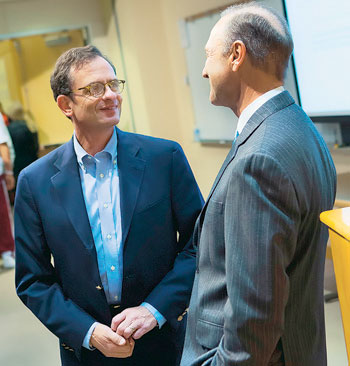
Weiss with Mark Crain, Simon Professor of Political Economy
Weiss, himself widely seen as a change agent, is presiding over his last Lafayette Convocation; he will assume the presidency of Haverford College next July after completing his eighth year at the helm at Lafayette.
Back in Markle Hall, he says, “Our work is not at all finished, but the major goals that I was brought in to meet have been accomplished. The College’s focus and trajectory are clear. The idea is to leave while you’re doing well and to let the institution hire a strong president to continue that trajectory.”
When he was named Lafayette’s 16th president, Weiss—then dean of the Krieger School of Arts and Sciences at Johns Hopkins, an expert on the art of medieval Europe in the Age of the Crusades, and also a former management consultant—commented that the decisions facing Lafayette in the future would be harder than those in the past. That turned out to be the case, he says. “Change is inevitably complicated and can seem slow. I think the challenge we face at Lafayette is that we are highly ambitious. The College has articulated a vision that has it wanting to be a stronger and in some ways a different institution. And by embracing excellence, we inevitably embrace change.”
Edward Ahart ’69, chair of the Board of Trustees and a member of the search committee that identified Weiss, says, “Even before we hired him, he had learned so much about the College, and he was very deliberate in talking about the steps that we—it was always ‘we’—would need to take to move the College forward.”
QUALITY MEASURES POINT UP
Asked what would impress observers about his legacy, Weiss says, “Every measure of quality is pointing up. That includes the number of student applicants, the depth and quality of the applicant pool, the faculty’s scholarly productivity and quality of teaching, the success of our graduates in winning national fellowships, foundation support for our academic initiatives, the evolution of our academic infrastructure, and the technological capacity of the institution. We’re doing the important things well.”
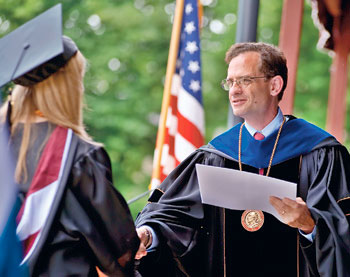 Many of those things are in the purview of Wendy Hill, now in her sixth year as provost and dean of the faculty. Among the most conspicuous dividends of the strategic-planning process led by Weiss, she says, is the growth of the faculty; the College is more than halfway to the goal of a 20 percent expansion. “We’re adding courses in areas where we simply didn’t have the depth to accommodate a burgeoning student demand,” she says.
Many of those things are in the purview of Wendy Hill, now in her sixth year as provost and dean of the faculty. Among the most conspicuous dividends of the strategic-planning process led by Weiss, she says, is the growth of the faculty; the College is more than halfway to the goal of a 20 percent expansion. “We’re adding courses in areas where we simply didn’t have the depth to accommodate a burgeoning student demand,” she says.
Hill points to other academic enhancements that have defined the Weiss years: shaping a new Common Course of Study; adding clarity to the tenure process; bringing more global awareness to the curriculum through, for example, a strengthened international affairs major and more focus on study-abroad opportunities. Building on its traditional strengths in engineering, Lafayette is increasing the exposure engineering majors have to the liberal arts and integrating the engineering perspective more effectively into the educational experience of non-engineers.
Under Weiss, the College has deepened “interdisciplinarity”; Rachel Brummel and Benjamin Cohen exemplify this initiative. Brummel was appointed to the new environmental studies program. Cohen, in his second year, is the first professor hired specifically for the engineering studies (bachelor of arts in engineering) program.
“From the time I interviewed, I felt the intellectual energy,” Brummel says. “People who have been here 20 years are still excited. The feeling is widespread that the College is only getting better.” As Cohen says, “It’s easy to catch the impression that this is a school on the rise.”
One strong indicator of a school on the rise is its student body. Lafayette received a record number of applications for admission to the current first-year class. Greg MacDonald, dean of admissions and financial aid, says Weiss provided a clear mandate for a more assertive admissions program, along with the resources to support it. Moving beyond what MacDonald calls “a tri-state dependence” on New York, New Jersey, and Pennsylvania, the College now recruits in some 10 areas of the United States where it had not previously set foot and in 16 other countries, including, for the first time, countries in Africa. Average SAT scores have reached historic highs for Lafayette in classes enrolled under Weiss, as has the number of U.S. students of color.
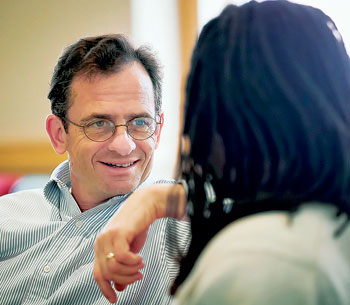
Weiss talked with Khali Ugdah ’10 at the McDonogh Network senior celebration and networking event.
“Dan sought input to these initiatives from the entire College community,” says trustee Alan Griffith ’64, former board chair and chair of the current presidential search committee. “By so doing, he built consensus and enthusiasm for them. He also recognized that much of a student’s learning occurs outside the classroom, and he has been determined to maximize the opportunities available for students to participate in activities that will foster intellectual and personal growth.” Griffith adds that the College’s current strategic plan, a reflection of Weiss’ leadership, “provides trustees, faculty, and the administration with a roadmap that will lead Lafayette to a position of national prominence in providing a widely respected undergraduate education.”
“Dan definitely has a broad vision of education. A big theme for him is that students shouldn’t just be driven by earning a degree, but they should be engaged with the society they’ll be graduating into.” -Teevrat Garg ’10
THRIVING IN A DOWNTURN
“I’ve always been impressed by Dan’s combination of academic credentials and executive skills,” says trustee Angel Mendez ’82, who worked closely with Weiss on a plan to integrate technology into the College’s strategic planning. “He has a way of thinking about process that turns ideas into actions. That’s a trait that a lot of academic leaders do not possess. And Dan has no trouble being himself in front of others, including agreeing to think differently about a situation that might seem to exist on a high moral plane, but that also has to be rooted in tough administrative realities.”
One arena in which Weiss’ skills have been tested is athletics. Early in his presidency, a working group looked at the rising cost of athletics in the college budget, the viability and sustainability of the Patriot League, and the academic credentials of student-athletes vis-à-vis their fellow students. This past February, the Patriot League decided to begin offering athletic scholarships in football beginning with 2013’s entering class; it previously allowed merit scholarships in all sports except football. When football aid was proposed in 2010, Weiss had spoken out against it.
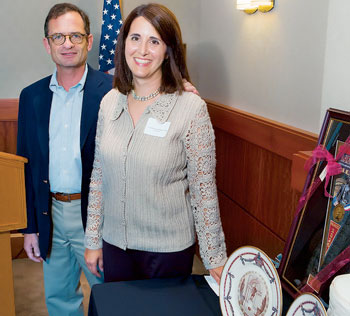
President Weiss presented Pamela Gaary Holran ’88 with the Bell Award for distinguished service at the 2012 alumni volunteer awards reception.
Today Weiss, who is chair of the Patriot League’s Council of Presidents, says, “The College has had to come to terms with a deep and enduring conflict. Many in the community believe that merit aid in athletics is not consistent with the values of the institution. But within the real world that we inhabit, participation in the Patriot League is a really strong positive; the Patriot League is the right place for Lafayette. I respect my fellow presidents, we agreed to come to consensus, and we move on from there.”
Among those on the athletics working group was trustee Robert Sell ’84, who served on the presidential search committee that identified Weiss and is on the current one. He says that through the athletics-related discussions, Weiss illustrated his ability to “distill a variety of inputs, factors, and desired directions into a singular vision.” Sell also notes Lafayette’s success at weathering the economic meltdown that began in 2008. “The way the College approached that very significant challenge was a testament to the kind of strategic thinking that characterizes Dan and the kind of decision-making structure that he had put in place.” The College ended up taking a balanced approach, he says. That meant “fiscal responsibility and operational and structural discipline on the one hand, but on the other hand, identifying areas of opportunity.”
Pamela Holran ’88, former Alumni Association president, says, “Dan has always showed a commitment to understanding the issues facing the College. Alumni would have different views on those issues, depending on lots of factors, including their particular emotional attachments. But he always provided me the opportunity to voice alumni opinions, which often would exist along a wide spectrum, along with my own opinions. He’s a good listener, and he’s always listened respectfully.”
Longtime faculty members similarly celebrate Weiss’ stewardship during the severe downturn. Alan Childs, a psychology professor and director of the College’s Center for the Integration of Teaching, Learning, and Scholarship, observes that Weiss strengthened the College’s academic core and “human capital,” even as higher education broadly was scaling back.
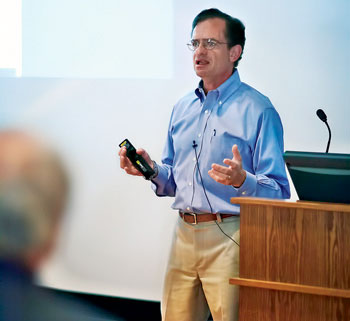
President Weiss taught the course The Classical Ideal in Greek Sculpture during Alumni Summer College.
ENGAGING WITH COMMUNITY
Despite the commitments of a college president, Weiss has continued to teach, currently on the subject of ancient Greek sculpture. He’s also known as a popular lecturer for Alumni Summer Colleges and alumni travel programs. “For me, teaching reinforces the idea that in a small-college environment, everybody, from the president on down, is part of an academic community. The most interesting thing about being part of an academic community is connecting with students.”
Teevrat Garg ’10, a Cornell graduate student in applied economics and management, connected with Weiss through the Forensics Society’s speech team and the College Fed Challenge team, both of which won national championships in 2009.
“Dan definitely has a broad vision of education. A big theme for him is that students shouldn’t just be driven by earning a degree, but they should be engaged with the society they’ll be graduating into,” he says. “When I talk with friends at other schools, none of them has the kind of personal interaction with their president that I had with Dan. It wasn’t unusual to see him on the steps of Skillman Library chatting with students.”
As president, Weiss has shown an expansive understanding of community. Among the featured speakers at Convocation was the mayor of Easton, Sal Panto, who regularly observes that “without Lafayette, the city would not be what it is today.” Sell, an Easton native, says he’s “never seen a better relationship between Lafayette and Easton.”

Rebecca Chopp, president, Swarthmore College (left) and President Weiss were co-hosts for the Future of the Liberal Arts College in America and Its Leadership Role in Education around the World.
GOING FORWARD
Weiss acknowledges that his personal trajectory, post-Lafayette, might seem unusual. The typical path would be deanship to college presidency to presidency of a research university. But he says he’s become more and more drawn to the model of the small, liberal arts college. That was the subject of a Lafayette-based conference in April that he organized with Rebecca Chopp, Swarthmore’s president. It drew national leaders from that sector.
During the next several years, he told his fellow educators, four factors will become more urgent: economics (investing in quality and innovation requires resources beyond those needed to keep pace with the cost of living); public perception of value (an increasing disconnect between colleges and the public on perceived value and affordability); demographics (within a decade minorities will comprise more than half of all children in the United States); and technology (including new learning platforms, some of which will provide academic credentials). It’s likely, he said, that there will be greater differentiation between sectors and institutions; that of the more than 4,000 institutions, some will not survive; and that online learning, open courses, and for-profit institutions will all continue to grow.
“For undergraduate education,” he told the conference, “the most well-funded and selective liberal arts colleges are uniquely well positioned to lead due to a strong and diversified resource base, the capacity to adapt more quickly, a proven model for learning, and a compelling vision.”
Today he says he has little doubt that even with all the systemic stresses ahead for higher education, Lafayette is well-positioned to keep prospering. “The next president will benefit from the continued return on our investment in the academic core. The visibility of Lafayette will continue to grow. I think the next several years promise to be really exciting here.”
Bliwise ’76 is editor of Duke Magazine and teaches magazine journalism at Duke University.